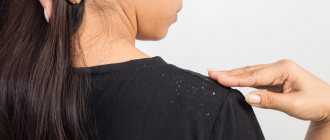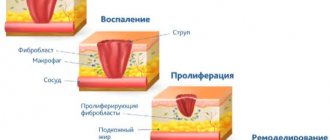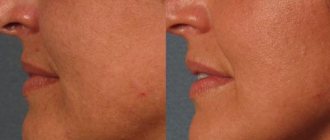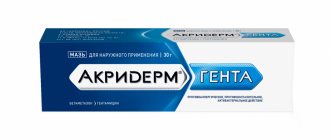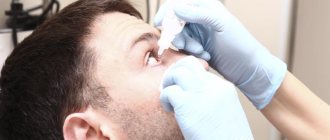Akriderm GK is a combination product used in the treatment of dermatological diseases. The effectiveness of the medicine is ensured by its multicomponent composition and its effect on one of the causes of skin problems - bacteria or fungi.
The use has contraindications and limitations, so it is important to study the instructions before starting use.
Composition and release form
Akriderm®
| Cream | 1 g |
| betamethasone dipropionate | 0.64 mg |
| excipients: nipagin; paraffin paraffin; petrolatum; propylene glycol; medical vaseline oil; emulsifying cetostearyl alcohol type A or emulsifying wax type “Lanette SX”; disodium salt of ethylenediaminetetraacetic acid (trilon B); sodium sulfite 7-water; purified water |
in tubes of 15 or 30 g; in a cardboard pack 1 tube.
Akriderm® GENTA
| Cream for external use | 1 g |
| betamethasone dipropionate | 0.64 mg |
| gentamicin sulfate | 1 mg |
| excipients: nipagin; propylene glycol; Vaseline oil; macrogol 20 cetostearyl ester; cetostearyl alcohol; disodium ethylenediaminetetraacetate; sodium phosphate disubstituted; potassium phosphate monosubstituted; purified water |
in tubes of 15 or 30 g; in a cardboard pack 1 tube.
Akriderm® GK
| Cream for external use | 1 g |
| betamethasone dipropionate | 0.64 mg |
| clotrimazole | 10 mg |
| gentamicin sulfate | 1 mg |
| excipients: petroleum jelly; propylene glycol; medical vaseline oil; cetostearyl alcohol; macrogol cetostearyl ester; trilon B; sodium dihydrogen phosphate dihydrate (sodium phosphate monosubstituted 2-water); purified water |
in tubes of 15 or 30 g; in a cardboard pack 1 tube.
Akriderm® SK
| Ointment for external use | 1 g |
| betamethasone dipropionate | 0.64 mg |
| (equivalent to 0.5 mg betamethasone) | |
| salicylic acid | 30 mg |
| excipients: petroleum jelly; Vaseline oil |
in tubes of 15 g or 30 g; in a cardboard pack 1 tube.
Characteristic
Akriderm®
Glucocorticosteroid for local use.
Akriderm® GENTA
Combined drug for external use (glucocorticosteroid + antibiotic-aminoglycoside).
Akriderm® GK
Combined preparation for external use (glucocorticosteroid + antibiotic-aminoglycoside + antifungal agent).
Akriderm® SK
Combined preparation for external use (glucocorticosteroid + keratolytic agent).
Pharmacodynamics
The corticosteroid betamethasone dipropionate inhibits the accumulation of leukocytes, the release of lysosomal enzymes and pro-inflammatory mediators at the site of inflammation, inhibits phagocytosis, reduces vascular tissue permeability, and prevents the formation of inflammatory edema.
Gentamicin is a broad-spectrum antibiotic from the aminoglycoside group. Has a bactericidal effect against pathogens of primary and secondary bacterial skin infections. Active against gram-negative bacteria: Pseudomonas aeruginosa, Aerobacter aerogenes, Escherichia coli, Proteus vulgaris, Klebsiella pneumoniae; gram-positive bacteria: Streptococcus spp. (susceptible strains of group A beta- and alpha-hemolytic streptococcus), Staphytococcus spp. (coagulase-positive, coagulase-negative and some penicillinase-producing strains). Inactive against anaerobes, fungi and viruses.
Clotrimazole has an antifungal effect by disrupting the synthesis of ergosterol, which is an integral part of the cell membrane of fungi. Active against: Trichophyton rubrum, Trichophyton mentagrophytes, Epidermophyton floccosum, Microsporum canis, Candida albicans, Malassezia furtur (Pityrosporum orbiculare).
Salicylic acid provides a keratolytic, antimicrobial effect, eliminates horny layers and promotes deeper penetration of GCS.
Mechanism of operation
The drug effectively relieves itching and redness in “pityriasis rosea”.
The drug "Akriderm" refers to hormonal agents intended for superficial treatment of affected skin. The components of the medication penetrate deeply into the cells of the dermis and begin their direct action: they stop allergic reactions, relieve itching and have an anti-inflammatory effect. Akriderm helps reduce the inflammatory process by blocking mediators and enzymes in the lesion. Betamethasone prevents the accumulation of leukocytes and interferes with phagocytosis. Additionally, the synthesis of membrane substances in the cell membrane of fungi is disrupted, leading to a slowdown in their growth and death. There is also an anti-edematous effect of the drug, which is achieved by reducing the permeability of the vascular walls. Consequently, Akriderm is effective both in the fight against microbes and fungi.
Indications of the drug Akriderm® SK
Akriderm®
Allergic skin diseases (including acute, subacute and chronic contact dermatitis, occupational dermatitis, seborrheic dermatitis, atopic dermatitis, solar dermatitis, neurodermatitis, pruritus, dyshidrotic dermatitis, eczema); acute and chronic forms of non-allergic dermatitis; psoriasis.
Akriderm® GENTA
Dermatitis (simple and allergic), especially secondarily infected, eczema (atopic, childhood, coin-shaped), atopic dermatitis (diffuse neurodermatitis), simple chronic lichen (limited neurodermatitis), solar dermatitis, exfoliative dermatitis, radiation dermatitis, diaper rash, psoriasis, itching.
Akriderm® GK
Treatment of dermatoses complicated by primary and/or secondary infection, pityriasis versicolor, limited and diffuse neurodermatitis, dermatomycosis (including inguinal, foot) caused by pathogens sensitive to the drug.
Akriderm® SK
Local treatment of dermatoses accompanied by hyperkeratosis: psoriasis, limited and diffuse neurodermatitis, lichen planus, eczema, dyshidrotic dermatitis, ichthyosis and ichthyosiform changes.
conclusions
This clinical study proves the high effectiveness, safety and tolerability of Akriderm GK
(betamethasone + gene-tamycin + clotrimazole) in the treatment of steroid-sensitive dermatoses complicated by bacterial and/or fungal infection.
The drug Akriderm GK
(betamethasone + gentamicin + clotrimazole) can be recommended for the treatment of dermatoses that occur both chronically (ointment) and with acute inflammatory phenomena (cream).
Dosage forms of the drug Akriderm GK
in the form of cream and ointment make it possible to treat dermatoses with different localizations.
The duration of use of the drug under the supervision of a physician can be from 7 days (allergic contact dermatitis) to 14 days (for example, when treating athlete's foot inguinal). The drug Akriderm GK
(betamethasone + gentamicin + clotrimazole) is produced in Russia, which is important within the framework of import substitution programs.
There is no conflict of interest.
Contraindications
Hypersensitivity to any of the components of the drug, skin tuberculosis, skin manifestations of syphilis, chicken pox, herpes simplex, skin post-vaccination reactions, open wounds, lactation and children under 1 year of age; additionally for the drug Akriderm®: trophic ulcers of the leg, rosacea, acne vulgaris; additionally for the drug Akriderm® GK: in the treatment of external otitis - perforation of the tympanic membrane; additionally for the drug Akriderm® SK: perioral dermatitis.
Use during pregnancy and breastfeeding
The safety of topical use of GCS in pregnant women has not been established; the prescription of drugs in this group during pregnancy is justified only if the potential benefit outweighs the possible risk. During pregnancy, drugs in this group should not be used in high doses or for a long time.
It has not been established whether local use of GCS can cause them to appear in mother's milk, so the issue of stopping breastfeeding should be addressed.
Side effects
When GCS is applied topically, the following may be observed: burning, irritation, dry skin, folliculitis, hypertrichosis, acne-like rashes, hypopigmentation, perioral dermatitis, allergic contact dermatitis. With long-term use, as well as the use of occlusive dressings, skin maceration, secondary infection, skin atrophy, prickly heat, purpura.
Akriderm®
When applied to large surfaces of the body, mainly in children, systemic side effects of GCS may occur (hyperglycemia, glucosuria, reversible inhibition of adrenal function, manifestation of Cushing's syndrome).
Akriderm® GENTA
Akriderm® GK
When applied to large surfaces of the body, mainly in children, systemic side effects of GCS (hyperglycemia, glucosuria, reversible inhibition of adrenal cortex function, manifestation of Cushing's syndrome) and gentamicin (nephrotoxic and ototoxic effects) may occur.
Akriderm® SK
When applied to large surfaces of the body, mainly in children, systemic side effects of GCS and salicylates may occur.
If adverse reactions occur that are not described in the instructions, you should consult a doctor.
Side effects
Uncontrolled use of Akriderm provokes negative consequences, such as:
- irritation and excessive dryness of the dermis;
- burning and itching;
- rashes;
- dermatitis;
- excessive hair growth;
- prickly heat.
If you apply ointment or cream to large areas of the epidermis, side symptoms may appear in the form of increased blood sugar levels and dysfunction of the adrenal cortex. During the use of Akriderm, increased excretion of glucose in urine may be observed and hypercortisolism may be diagnosed.
Directions for use and doses
Akriderm®
Akriderm® GENTA
Akriderm® GK
Externally. Apply a thin layer to the affected area of the skin 2 times a day - morning and evening. Another frequency of use can be determined by the doctor, based on the severity of the disease. In mild cases, it is enough to apply the cream, as a rule, once a day; For more severe lesions, more frequent use may be necessary.
The duration of treatment depends on the effectiveness and tolerability of therapy and is 2–4 weeks.
If clinical improvement does not occur, it is necessary to clarify the diagnosis.
Akriderm® SK
Externally. Apply a thin layer to the affected area of the skin 2 times a day - morning and evening. Another frequency of use can be determined by the doctor, based on the severity of the disease. In mild cases, it is enough to apply the ointment, as a rule, once a day; For more severe lesions, more frequent use may be necessary.
Instructions for use of "Akriderm" in the treatment of lichen
Doctors recommend using Akriderm SK ointment in the treatment of lichen planus, which contains not only betamethasone, but also salicylic acid, which provides an additional keratolytic effect. Thanks to this substance, the penetration of the hormone to damaged tissues improves, which speeds up treatment and increases its effectiveness. The medicine should be applied to the affected dermis in a thin layer 3 times a day. Usually the therapeutic course is 20-30 days, but if it is necessary to continue treatment, the daily dosage is reduced to 2 applications.
special instructions
If signs of hypersensitivity or skin irritation associated with the use of drugs are observed, treatment should be discontinued and adequate therapy should be selected for the patient.
With prolonged treatment, when applying drugs to large surfaces of the skin, when using occlusive dressings, and also in children, systemic absorption of GCS is possible.
For children over 1 year of age, medications are prescribed only according to strict indications and under medical supervision, because Systemic side effects associated with betamethasone may develop. When using the drug on large surfaces and/or under an occlusive dressing, suppression of the function of the hypothalamic-pituitary-adrenal system and the development of symptoms of hypercortisolism may occur; a decrease in the excretion of growth hormone and an increase in intracranial pressure may be observed.
On the skin of the face more often than on other surfaces of the body, after long-term treatment with topical corticosteroids, atrophic changes may appear; the course of treatment in this case should not exceed 5 days.
The cream and ointment are not intended for use in ophthalmology. Avoid getting the drug into your eyes.
With long-term use of the drug, its withdrawal should be carried out gradually.
Analogues of the drug
For patients who have not been helped by the described anti-lichen medication or for other reasons are unable to use it, doctors prescribe similar medications that are similar in their active substance and mechanism of action on the human body. Hormonal medication can be replaced by:
“Celestoderm” is one of the analogues of this group.
"Beloderm";- "Kuterid";
- "Betamethasone";
- "Celeston";
- "Diprospan";
- "Flosteron";
- "Celestoderm";
- "Betnovate";
- "Celeston."

